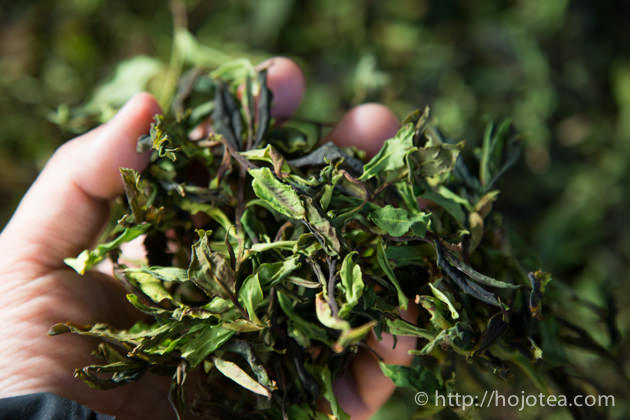- HOME >
- Types of Tea
Making Da Xue Shan Wild White Tea 2017
- [2017.04.16] Posted By Akira Hojo
We have been producing white tea using the wild tea grown in Da Xue Shan.
Last year we introduced this tea. But due to extremely limited quantity, it was sold out in a few days.
This year, we physically involved in this tea production and worked very hard to produce more quantity. We also studied a lot of technical parameters and trying to improve the quality.
Wild tea was traditionally consumed by farmers
The fresh tealeaf is collected from the wild tea tree, Camelia taliensis that grown in Da Xue Shan. In Chinese, Da Xue Shan means Great Snow Mountain. Camelia taliensis is the tea species closely related to Camelia sinensis. Since more than a few hundred years ago, the wild tea was processed and drunk by local farmers in the mountains. Since 10-15 years ago, this tea was being introduced to outside and it became famous rapidly. Nowadays, this tea becomes one of the income resources for a farmer who lives in the remote village by the mountain. Recently the wild tea is processed into not only pu-erh tea but also into black tea. Nevertheless, it is very rare that this tea is processed into white tea.
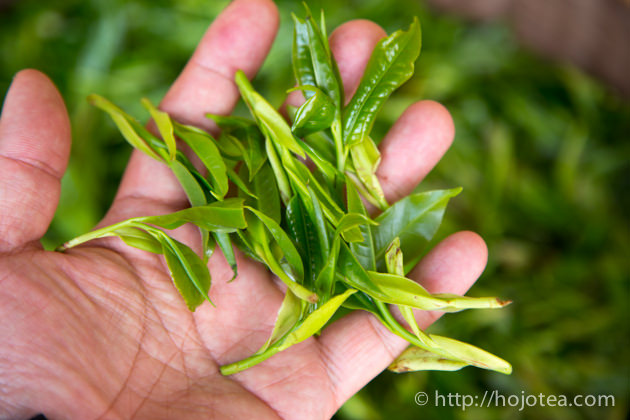
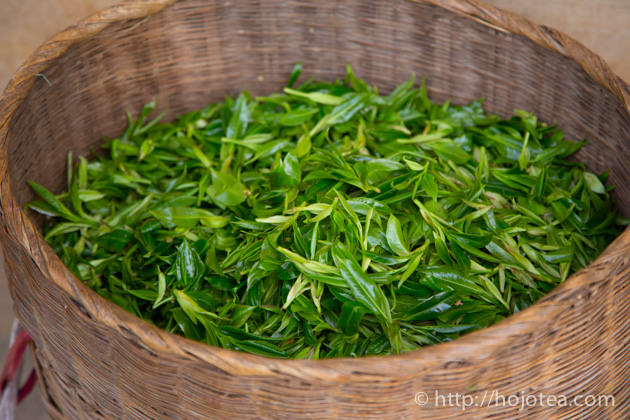
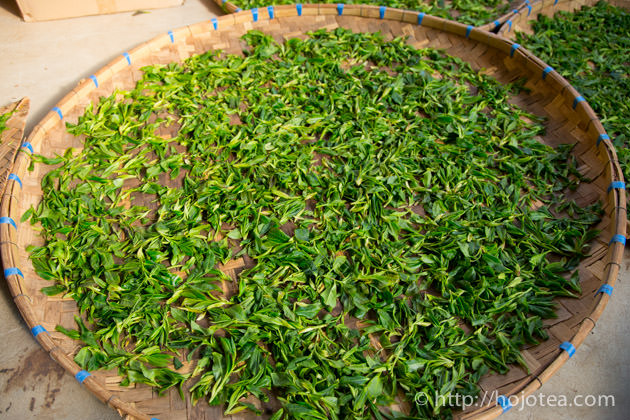
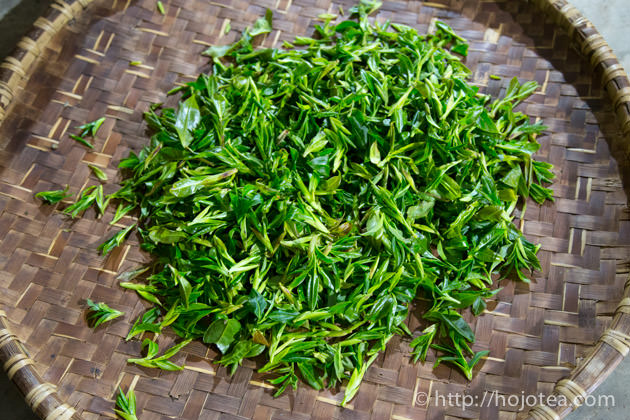
Tea leaves of wild tea
We decided to produce tea with 1 bud and 3-4 leaves in order to get stronger taste
Last year, this tea was made of small tea buds. It definitely looked very lovely and attractive. The small tea bud gives very mellow mouth feel. However, I wanted to make this tea more complex in flavor and rich in taste. So we decided to collect more grown-up tealeaf that consists of 1 bud and 3-4 leaves. The leaves are richer in poly phenol and it contributes a lot to tea flavor, particularly when tea is kept for some time.
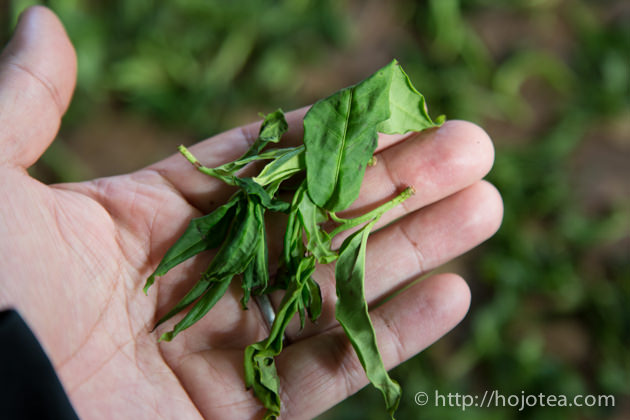
The outlook of tea leaves during withering process

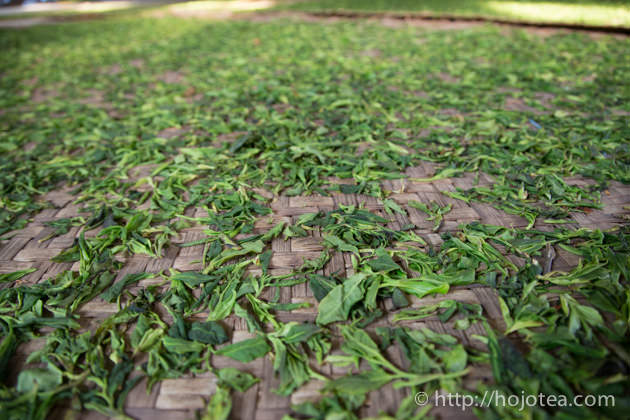


We managed the process and involved in making tea
Since this tea is very rare and less common in tea market, there are many uncertainties about the processing. For example, we are not clear about the optimum withering time and whether or not we should ventilate the tea during withering. Fortunately, we came to Yunnan very early this year. We have sufficient time to carry out many experiments to confirm the necessary parameter one by one. We set the parameter for each process, and directly involve in production work to monitor the outcome of each parameter. The tea manufacturer was actively cooperated to let us use his facility and give us a freedom to arrange the process.

We conducted long withering in order to enhance the tea flavor
The making of white tea involves withering process. The withering and drying with natural wind sounds similar. But in tea making, these are different. Withering means slowly reducing moisture and trigger the fermentation by the dehydration stress. If the ventilation is too intense, tea will get dried before it is withered. On the contrary, if there is no ventilation and the humidity of environment is too high, tea will be over fermented and caused stale flavor. This effect is just like the wet clothes being hanged in a room with no ventilation. So it is very crucial to control the humidity and ventilation of withering room, and the duration of withering process. We conducted withering for three days in order to bring out the floral and clean flavor.


We have just completed the process this week. We are planning to release the loose tea on pre-booking basis. We will announce it once the product is sorted and ready for export from China.
Related Articles
How to get the latest update on HOJO?
1. Follow Twitter, 2. Click "Like" on Facebook, and 3. Subscribe in newsletter. You can have the latest tea news from HOJO.
 Subscribe the Newsletter to enjoy the privileges
Subscribe the Newsletter to enjoy the privileges- You may receive a free sample upon purchase, or you may have the priority to purchase special products. So please remember to subscribe our newsletter as well as the social network.
- Myanmar White Tea Bud 2013 from Guo Gan, Myanmar
- We have released a raw Pu-erh tea, 緬甸白芽茶 2013 (Myanmar White Tea Bud 2013), produced by ethnic minorities in t …
- Yong De Wild White Tea 2025 Loose Leaf Limited Release
- We have released Yong De Wild White Tea Loose 2025. For the 2025 harvest, only the loose-leaf type was …
NEW ARTICLES
 Myanmar White Tea Bud 2013 from Guo Gan, Myanmar
Myanmar White Tea Bud 2013 from Guo Gan, Myanmar- We have released a raw Pu-erh tea, 緬甸白芽茶 2013 (Myanmar White Tea Bud 2013), produced by ethnic minorities in t …
 Yong De Wild White Tea 2025 Loose Leaf Limited Release
Yong De Wild White Tea 2025 Loose Leaf Limited Release- We have released Yong De Wild White Tea Loose 2025. For the 2025 harvest, only the loose-leaf type was …
 Experience the True Freshness of Raw Pu-erh : Tang Jia 2025 Loose Leaf Release
Experience the True Freshness of Raw Pu-erh : Tang Jia 2025 Loose Leaf Release- We have released Tang Jia Raw Pu-erh Tea 唐家古樹生茶 2025 Loose Leaf. Among HOJO’s raw pu-erh teas, Tang Jia Raw Pu …
 Yunnan Chun Jian Green Tea from High Mountain Gardens
Yunnan Chun Jian Green Tea from High Mountain Gardens- Yunnan Chun Jian Green Tea is now available. This tea is made from naturally grown leaves harvested from high …
 Limited Loose Leaf Release of 2025 Da Xue Shan Wild Raw Pu-erh Tea
Limited Loose Leaf Release of 2025 Da Xue Shan Wild Raw Pu-erh Tea- We have released the 2025 loose-leaf version of Da Xue Shan Wild Raw Pu-erh Tea. This tea comes from wild tea …
 Discover a New Way to Enjoy Tea: Cooking Rice with Tea
Discover a New Way to Enjoy Tea: Cooking Rice with Tea- Cooking rice with tea is a simple idea, but it brings surprisingly satisfying results. The tea’s flavour seeps …
 2025 Da Xue Shan Wild White Tea Now Available from Yunnan
2025 Da Xue Shan Wild White Tea Now Available from Yunnan- The 2025 harvest of Da Xue Shan Wild White Tea is now available. Crafted from truly wild Camellia taliensis tr …
 Fresh 2025 Yunnan White Tea – Select Your Favourite Lot Before Blending
Fresh 2025 Yunnan White Tea – Select Your Favourite Lot Before Blending- Freshly crafted in Yunnan and just arrived in KL, our new 2025 white tea is now available at our Gardens Mall …
 2024 Dong Shan Raw Pu-erh Tea – Crafted with the Producer for Desired Quality
2024 Dong Shan Raw Pu-erh Tea – Crafted with the Producer for Desired Quality- We have released the 2024 cake of Dong Shan Raw Pu-erh Tea. Earlier, we offered the loose-leaf version from th …
 Development of Firewood Roasted Hojicha Using Naturally Grown Tea from Yunnan
Development of Firewood Roasted Hojicha Using Naturally Grown Tea from Yunnan- We are currently staying in Yunnan Province for tea production. As the season nears its end, tea trees with pa …
Category
- New Arrival at HOJO Online Shop
- Featured Articles
- Newsletter
- Types of Tea
- Origin of Tea
- Teapot and Tea Equipment
- Tea Column
- How to enjoy tea
- Tea Processing
- How to choose quality tea
- Tea constituents and functional effect
- Safety of Tea
- Foods
- Tea Business Operation
- Hobby and Outdoor Activity
- Ranking of Tea
- Video
- FAQ
- Media Release
Profile

- AKIRA HOJO
- I invite you to experience my tea selections.I was born in Nagano, Japan. In university, I studied agricultural chemistry, and I have the master degree in food science. I worked in Japanese food industry for 10 years. I involved in R&D, QC and QA. As a factory manager, I implemented ISO9000 series and managed the factory.
- The Art of Tea Magazine
- We posted the article on “The Art of Tea Magazine No.9, the magazine is published in Taiwan. We featured …
- New Straits Times
- The Malaysian National Newspaper, New Straits Times featured HOJO Tea on 17-Oct-2007.
Shop Info

Address:Lot No. T-215, 3rd Floor, The Gardens Mall, Mid Valley City, Lingkaran Syed Putra, 59200 Kuala Lumpur
Tel: +603-2287-4537
Business Hour: 10am to 10pm

